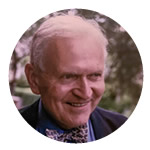
In Memoriam

In memoriam of Professor Erik Hjorth-Hansen (1933-2021)
Professor Emeritus at the Norwegian University of Science and Education, NTNU, Erik Hjorth-Hansen, passed away in 2021 at the age of 88. He was an eminent member of the international wind engineering community and founder of the Norwegian Society for Wind Engineering (2005).
He studied civil engineering at the Norwegian Institute of Technology in Trondheim (NTH, now NTNU), where his uncle, Arne Selberg, introduced wind engineering for civil applications in 1954. After graduation in 1958, he started the career as consultant engineer at Sven Tyrén AB in Stockholm. Two years later he returned to NTH/NTNU, where he worked as a research fellow, laboratory engineer and professor until 2010. After the retirement, he remained active for more than a decade.
Erik developed his expertise in bridge aerodynamics in close and long-lasting collaboration with the Norwegian Public Roads Administration. He was actively involved in the design of closed box girders, as a replacement of truss stiffeners, for slender Norwegian suspension bridges with one traffic lane in each direction. He orchestrated extensive studies for wind resistant design of the Hardanger bridge, currently the longest suspension bridge in Norway (1310 m main span). Major Scandinavian bridge projects such as bridges across the Little Belt, the East Great Belt, Sunningesund and Øresund also benefitted from Erik’s expertise.
Erik continuously developed and improved the practice of wind tunnel investigations with bridge deck section models. He treated a section model suspended in a dynamic rig as a structure on its own and carefully considered effects of non-linear damping, geometric stiffness etc. on the model wind-induced response. He reviewed the practice of section model tests and its role for assessment of bridge aerodynamic performance in the seminal paper from 1992 [1].
In the sixties and seventies, he explored bridge aerodynamic stability limit in smooth flow, in relation to bridge dynamic characteristics and the girder aerodynamic shape, as well as a function of response amplitude and angle of incidence. Vortex induced vibrations of bridges and other structures and the mitigation measures were another topic of investigation. From the eighties, his experimental and theoretical work was largely devoted to wind loads due to turbulence and the effects on slender structures. He developed a Ph.D. course in Wind Engineering at NTH in 1989, with buffeting loads as the main topic. Erik also gave lectures on wind effects on structures to practicing engineers and was heavily involved in the development of the Norwegian wind load standard. He also worked on several field measurement campaigns on bridges and other structures.
Erik collaborated with the major international capacities in the field. He had both professional and personal contacts with colleagues from Canada, Japan, Denmark, UK, USA and beyond. He regularly attended the international and regional wind engineering conferences. His reflective discussions and experience sharing contributed to state-of-the-art in the field of wind engineering. His last conference attendance was in Florence in 2009 (5EACWE).
Erik is remembered for his brilliant experimental work and theoretical knowledge, and captivating dissemination. They are a continuous source of inspiration in wind engineering research and practice.
Jasna Bogunovic Jakobsen, former PhD student
Professor, University of Stavanger
[1] E. Hjorth-Hansen (1992), Section model tests, [in] Aerodynamics of Large Bridges, ed. A. Larsen, Balkema.

In memoriam of Professor Manabu Ito (1930-2023)
Deplorably we must announce the passing of Professor Manabu Ito, former President of the Japan Association for Wind Engineering (JAWE), on February 12, 2023, at the age of 92.
After obtaining his Doctor of Engineering degree under the supervision of Professor Atsushi Hirai, he began his academic career at the Department of Civil Engineering of the University of Tokyo. He promoted to a professor at the University of Tokyo in 1972 until his retirement in 1991.
Professor Ito played a central role alongside Chairman Hatsuo Ishizaki in the establishment of the JAWE in 1976. In 1986, he became the second president of the association, dedicating himself to the society’s activities for six years. He received the JAWE Award in 1994 and IAWE Presidential Award in 2021. He had been honored as an honorary member of the JAWE.
Professor Ito’s contributions was his active supervision in major bridge projects in and out of Japan and participation in international engineering societies, including his activity as a president of IABSE for 2001-2004 . At these occasions he often was accompanied by his wife, Atsuko, and they formed numerous friendships with researchers and their families across the world. Such international orientation of the Ito’s influenced, now succeeded by, his students.

In memoriam of Professor Hiromasa Kawai (1947-2022)
Hiromasa Kawai, professor emeritus of Kyoto University passed away on April 23rd, 2022. He had been a faculty member of Tokyo Denki University for 23 years since 1977 and Disaster Prevention Research Institute, Kyoto University for 12 years since 2000. His area of expertise was building aerodynamics, specializing in vortex-induced vibration of high-rise buildings and wind forces on buildings and houses. In his research activities, he has been conducting research on strong wind disasters and wind resistance safety. He contributed to the wind resistance design in the field of buildings and houses. He will clarify the characteristics and generation mechanism of aerodynamically unstable vibrations such as vortex-induced vibration, galloping and flutter on the wind-induced vibration of high-rise buildings. He studied on the response analysis method and instability and established a vibration prevention method. He contributed to the development of JAWE (Japan Association of Wind Engineering) as a presidents in 2010 – 2011, board member and was the chairperson of several committees. Also, he served as chairperson of several committees of AIJ (Architectural Institute of Japan) and played a leading role in the creation of various standards, guidelines related to wind pressure and wind resistance design, resulting a great contribution to the rationalization and progress of wind-resistant design of buildings and houses in Japan. After he was assigned to Kyoto University, he lived alone in Kyoto, but he was always on good terms with his wife, who came to visit him from Tokyo. Unfortunately, he lost his wife first and seems to have felt lonely, but now we hope that the two of them are on good terms again.

In memoriam of Professor John Hugh George Macdonald (1969-2022)
On Saturday, March 5, 2022, John Hugh George Macdonald passed away suddenly at the age of 53.
John was a Professor of Structural Dynamics at the department of Civil Engineering of Bristol University, a position that perfectly suited his inclination to get to the bottom of things, to learn and to teach in the most generous way. He was at the prime of his research and academic career, the prime of his life with his wife, Jane, and children, Jake and Holly, his extended family and his large network of friends and colleagues in the UK and around the world. His passing has left a marked void for his family, his colleagues at Bristol and in our wind engineering profession that only time will help to lessen.
John’s association with wind engineering dates from 1994 when he joined Bristol University as a research assistant and Ph.D. student following undergraduate studies in Civil Engineering at Cambridge. His Ph.D. research focused on the wind effects on the Second Severn Bridge that was under construction at the time across River Severn, a soothing 16 km bike ride away from the university. The bridge construction and the wind instabilities observed on site brought him to jump into wind engineering, studying wind effects while being outdoors in the elements which he loved. This is where he first studied at full-scale vortex-shedding excitation of a bridge deck and discovered the complexity of the dynamics and aerodynamics of bridge cables, a topic that would occupy his research mind for many years afterwards. The quality of his early research work at Bristol on the Second Severn Bridge was recognised through the Cooper Hills Medal of the Institution of Civil Engineers.
His contributions to wind engineering and structural dynamics are numerous and significant. In particular, his research work on the aerodynamics of cables along with several graduate students has become a key reference providing a solid analytical framework to predict complex aerodynamic instabilities backed up with laboratory and field observations. Applied mathematics was one of John’s strengths which explains his desire to tackle the most complex structural dynamic problems, while remaining practical. His recent analytical work published in Nature on the causes of pedestrian-induced vibrations of the Millennium Bridge as a case study is a good example of that.
John was generous with his time, providing leadership to wind engineering organisations such as the Wind Engineering Society and IAWE, co-supervising students with colleagues at home and abroad and actively participating in international development activities in Africa and Latin America. His integrity, positive attitude and enthusiasm were sought after by everyone. One wanted John on scientific or examining committees, his opinion was trusted.
Above all, John was a respectful, kind, and fun person with a calming genuine smile. He loved the outdoors, canoeing in particular, hiking, experiencing new things and debating a little. He had influence, cared for people, for his students, his friends and colleagues and first and foremost his family. He is missed dearly.
Guy L. Larose, Senior Technical Director, RWDI. Co-chair of Scientific Committee, 10th ICWE Copenhagen.

In memoriam of Professor Giovanni Solari (1953-2020)
Professor of Structural Engineering at the University of Genoa since 1990.
A giant in the field of wind engineering, where he made insightful research on modeling wind loads on structures, with special regard to the closed form solution of the alongwind and 3D response of structures, the equivalent wind spectrum technique, the proper orthogonal decomposition and double modal transformation, the wind-induced fatigue, the extreme wind speed statistics and the thunderstorm outflows. Many of these contributions had a relevant impact on the engineering practice, the structural design, and the codification sector. Also for these reasons, in 2017 he was awarded with an ERC Advanced Grant, THUNDERR, which has produced some of the most cutting edge research in the field and has matriculated a very talented cadre of students from the newly installed Ph.D. program at the University of Genoa in “Wind Science and Engineering”.
In 1999, the Wind Engineering community entrusted him to chair the panel appointed to create a new framework and organization of the International Association of Wind Engineering (IAWE), then he was elected as first IAWE President.
He received several scientific awards of great international prestige, including the Raymond C. Reese Research Prize, the Jack Cermak Medal, the Robert H Scanlan Medal and the Nathan M. Newmark Medal of ASCE (American Society of Civil Engineers), the Alan Davenport Medal of IAWE, the Otto H.G. Flachsbart Medal of Windtechnologische Gesellschaft e.V. Germany – Austria – Switzerland, the Senior Special Award of EASD (European Association for Structural Dynamics). He received an honorary Doctor Honoris Causa at the Technical University of Civil Engineering of Bucharest (Romania). He was visiting Professor and Senior Adviser of the first Academic Council of Beijing’s Key Laboratory of Structural Wind Engineering and Urban Wind Environment at the Beijing Jaotong University (Beijing, China), Guest Professor and Lecturer at the Universidad de la Republica of Montevideo (Uruguay), Adjunct Professor at the Faculty of Engineering of the University of Western Ontario (London, ON, Canada), Honorary Professor at the Shijiazhuang Tiedao University and Central South University Changsha (China).
He was an honest, committed, driven, unassuming scholar, and a real gentleman. He was a “maestro” for many young people, who had the privilege of collaborating with him in his research activities.
Giuseppe Piccardo, Maria Pia Repetto, Università degli Studi di Genova – Dipartimento di Ingegneria Civile, Chimica e Ambientale (DICCA).

In memoriam of Professor Robert Law Wardlaw (1927-2022)
On Friday August 26, 2022, Robert (Bob) Law Wardlaw passed away at the age of 95 at his home in Ottawa, Ontario.
Bob played an important role in the development of wind engineering in Canada, leading a very active group at Canada’s National Research Council (NRC) in Ottawa from the 1960’s through to his retirement in 1990. He joined NRC in 1949 after obtaining his B.Sc. in Engineering Science from the University of Toronto. In 1956 he moved to the Low-Speed Aeronautical Laboratory of NRC where he became involved in wind engineering in the 1960’s. These were early days in wind engineering with the first boundary layer wind tunnels being constructed in the USA by Jack Cermak and in Canada by Alan Davenport.
NRC began to receive an increasing number of enquiries from structural designers, architects, industrial companies, and planners looking for help in designing their projects or products for wind. NRC’s wind tunnels were originally built for aeronautical applications, but Bob Wardlaw and his group devised ways of developing thick boundary layers in them suitable for wind engineering applications. Also, sectional model test rigs were designed and fabricated that allowed the tunnels to be used to examine the aeroelastic stability of structures such as long span bridges and electrical power cables.
As a result, under Bob’s leadership, his group became involved in a very wide variety of wind engineering applications in Canada and the USA. These included: major bridge projects; electrical transmission lines; tall buildings; pedestrian comfort studies; industrial structures for the nuclear power industry; roadway sign structures; stadium structures; wind effects on industrial weigh scales; wind uplift of roof paving and gravel systems; vehicle drag reduction; and the aerodynamics of competitive cycling and skiing. Bob’s contributions became well recognized in Canada and abroad. He also collaborated with other leading researchers, including Prof. Bob Scanlan in the USA. His low-key leadership style encouraged those working with him to develop their own ideas and confidence in problem solving. Informal discussion, frequently over coffee and tea breaks, often led to new and fruitful initiatives. Also, in project meetings with designers, Bob had a relaxed way of setting people at ease. Getting to know people first was more important to him than jumping straight into the engineering problem and this led to trusting relationships and productive collaborations. He also served as a link between designers with similar interests. For example, in Canada he introduced two young bridge engineers, Peter Buckland and Peter Taylor, to each other which led them to form a new company, Buckland and Taylor Limited, in Vancouver. The company grew to be a premier bridge design firm that set new standards for elegance and efficiency of design, especially of cable-stayed bridges. It eventually became part of the international consultancy COWI.
After retiring from NRC Bob continued for some years to provide advice as an independent consultant but mostly enjoyed spending time with his family and friends. He and his wife Jane were happily married for 61 years and had five children and 10 grand children with whom they enjoyed an active lifestyle of cross-country skiing, canoeing, travel and hiking. He contributed much to the development of wind engineering in Canada and influenced the careers of many. He will be remembered as a fine mentor, colleague, and friend.
Peter A. Irwin PhD, P.Eng., CM, FCAE, NAE, FCSCE, FEIC, FASCE, FSEI
Senior Technical Director and Past President RWDI.
